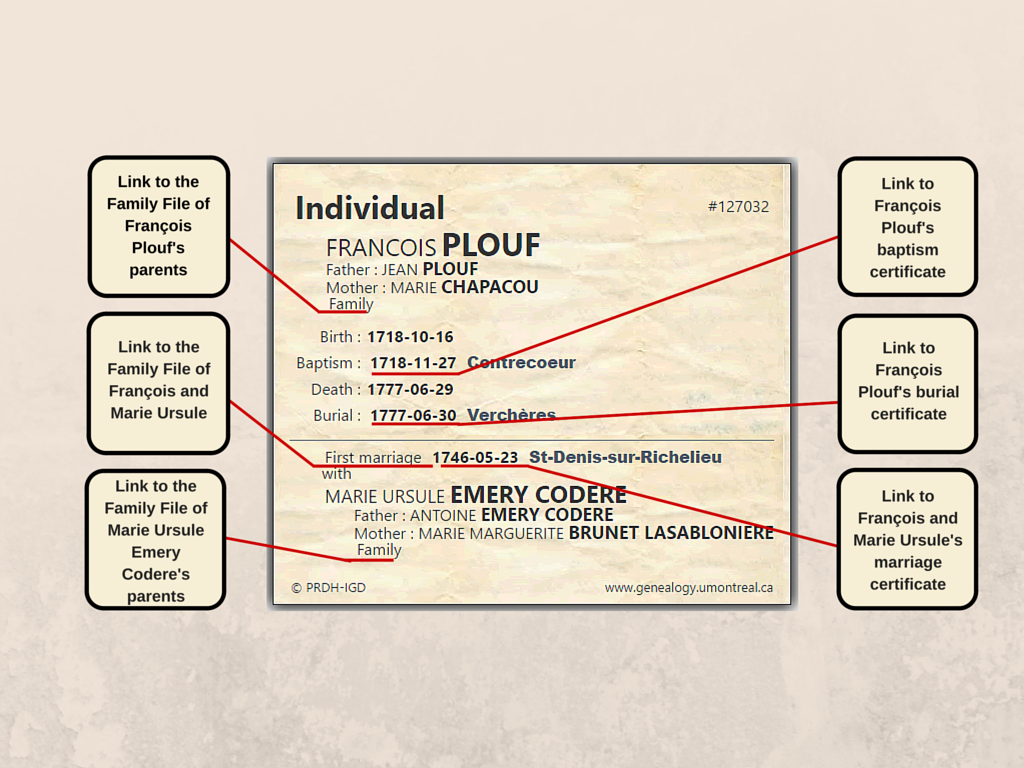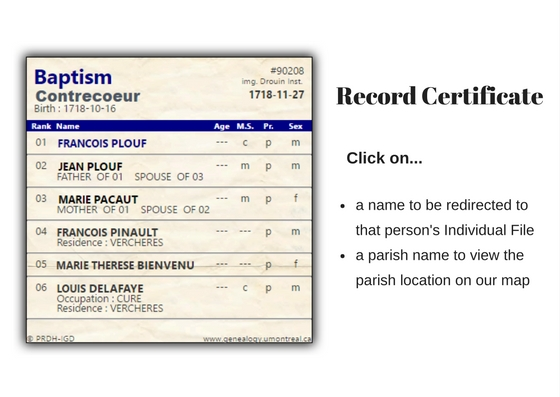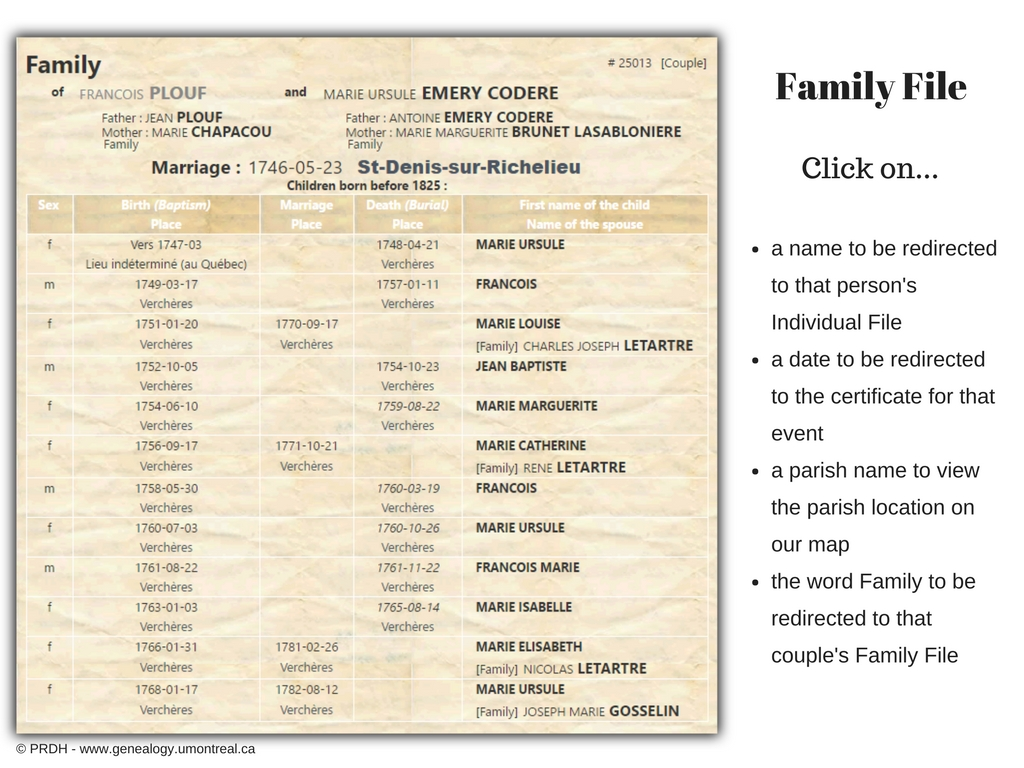Your genealogical research might have left you with the impression that your ancestors liked to change names quite often. The concept of “dit names”, which was the subject of a previous blog post, sheds light on a part of this variation, which can be obscure to a present-day observer.
Although baptism was the cornerstone of civil identity in French Canada for four centuries, this identity was not, until the beginning of the 20th century, as constraining as it is today. It was not unusual for an individual to use different first and last names in the course of a lifetime. This phenomenon is fostered by the orthographic instability of proper names, the flexibility of the civil registration system as well as illiteracy.
This article offers some tips to keep in mind in order to locate all the occurrences of your ancestors in the archives.
Do not rely on spelling
This tip may seem trivial to experienced genealogists, but it is a very handy one. For example, the ancestor of the Hétu family would spell his name Estur. The silent ‹ s › and ‹ r › were orthographic relics, for which the French language is renowned. The ‹ h › was added over the years as an ornamental letter.
Orthographic variation should not be systematically attributed to illiteracy, as evidenced by the Hénault family. Four members of this educated and wealthy family signed, in 1816, the marriage record of Honoré Hénault and Julienne Mailloux and spelled their last name three different ways: Hénault, Heneault and Eno. The priest chose the unaccented variant Henault.

Before standardization of proper names, their spelling would be determined to some extent by the whims of the priest, the notary and the individual him or herself.
Keep in mind that language changes
Most Dions are patronymic descendants of pioneer Jean Guyon. How is that possible? First, note that Guyon is pronounced Guee-yon and not Gu-yon. Nowadays, hard ‹ g › is articulated at the velum while ‹ d › is articulated behind the upper front teeth. However, in the past, ‹ g ›, when followed by a vowel pronounced from the front of the mouth like ‹ ee ›, tended to move forward. This linguistic process induced a shift from Guyon to Dion.
Guyot, which derives from the first name Guy just like Guyon, went through a parallel transformation and gave birth to Diotte. However, some names went the opposite way: Pierre Andiran is the ancestor of all Languirands.
Similarly, the Chiasson and Giasson families share the same origin. Only the vibration of the vocal folds in the onset of the word separates those two names. In the absence of a fixed spelling, this phonetic feature was likely to fluctuate across regions, time periods and individuals. Like Guyon and Dion, these two names are two sides of the same coin.
Vowels are also impacted by linguistic change. Maybe you will be surprised to learn that most Harveys from Quebec did not receive their name from an Anglo-Saxon immigrant. It rather comes from the name Hervé.
Be on the lookout for deleted or added sounds
The absence of a strict orthographic norm when it comes to proper nouns opens the door to oral variation. Certain sounds and syllables have a natural tendency to appear or disappear according to their position in the word.
One reason for adding segments is the introduction of definite articles le, la and l’(the) in front of last names: it was usual to call people le Gagnon, la Corriveau (a famous folkloric and historical figure) or l’Andiran. Reinterpretation of this structure in a merged form completes the shift from Andiran to Languirand.
Now, pronounce Reguindeau (Ruh-guin-do) out loud, then Reyindeau (Ruh-yin-do). You will probably notice the similarity between the two forms, and how easy it is to go from one to the other. The change from hard ‹ g › to ‹ y › is an example of palatalization. English yellow is linked to German gelb through the same process. You might have recognized the French-Canadian last name Riendeau (Ryin-do), inherited from Joachim Reguindeau from La Rochelle, France.
The pioneer François Amirault dit Tourangeau offers another example of deletion: most of his patronymic descendants use the name Mireault or an orthographic variant. The reverse phenomenon can also be found as the female first name Zélie produced Azélie.
The alternation between first names that are essentially distinguished by a few additional sounds can be found without regard for etymological cognateness. In French Canada, Élisabeth and its ancient derivative Isabelle behaved as two variants of the same name until the 19th century. However, Domitille & Mathilde, Jérémie & Rémi, Apolline & Pauline as well as Napoléon, Paul & Léon are not related.
Detect shared consonants, vowels and syllables
Beyond truncated segments, some names share more subtle similarities that explain why they have often been mixed up, or even used interchangeably.
Apolline & Hippolyte, Jérémie & Germain, Mathilde & Martine as well as Alice & Élise illustrate this phenomenon. In other cases, the similarities seem even more tenuous. It is improbable that a present-day genealogist would spontaneously perceive a link between Angélique, Julie and Judith. Yet records show that these three first names have often been used alternately.

Focus on the most distinctive part
A first name with a rare ending is susceptible to be substituted with other names that share the same characteristic. It is the case of David & Ovide or Stanislas & Wenceslas.
The most distinctive part of a first name, or even a last name, sometimes acts as a nucleus that can be completed with a variety of prefixes and suffixes. Thus, Rose generates Rosalie, Rosanna, Rosina and Rosa. The female first names structured around the nucleus ‹ del › provide another example. By varying starts and endings, this group includes Adèle, Adélaïde, Adeline, Délie, Délina, Délia, Délima, Odeline and even Odile, which are not all etymologically related but came to sound alike and sometimes be used alike.
Similarly, it is not surprising that Brunet is occasionally substituted with Bruneau or Brunel, and Gendreau may alternate with Gendron.
Know the first name combinations inspired by the saints
To shed light on this last type of variation, religion rather than linguistics comes in handy. Some saints’ and blesseds’ names are composed of several parts, with Jean Baptiste (John the Baptist) being the most well-known. An individual may use one part or another. Thus, Rose de Lima (Rose of Lima) paves the way for Rose and its sisters Rosalie, Rosanna, Rosa, as well as Délima and even Délina.
François Xavier (Francis Xavier), Jean François Régis (John Francis Regis), Jeanne Françoise Frémyot de Chantal (Jane Frances de Chantal) and Marie des Anges (Mary of the Angels), among others, also open the door to alternation between their parts.
The resemblance function in the LAFRANCE and on PRDH-IGD.com
The resemblance (or likeliness) function available on the search engines of both PRDH-IGD and GenealogyQuebec.com‘s LAFRANCE will neutralize some of this variation, making genealogical research easier.

For example, searching for “Mathilde” will generate a list containing women named Mathilde, Domitille, Martine, Donatille, Mélitime, Métheldée and Militilde, with their various spellings.
Marielle Côté-Gendreau
Student and Université de Montréal’s Programme de recherche en démographie historique (PRDH) collaborator.




















